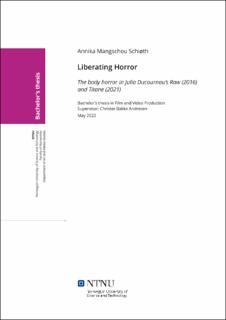| dc.contributor.advisor | Andresen, Christer Bakke | |
| dc.contributor.author | Schiøth, Annika Mangschou | |
| dc.date.accessioned | 2022-07-07T17:21:24Z | |
| dc.date.available | 2022-07-07T17:21:24Z | |
| dc.date.issued | 2022 | |
| dc.identifier | no.ntnu:inspera:104821360:51728713 | |
| dc.identifier.uri | https://hdl.handle.net/11250/3003662 | |
| dc.description.abstract | Hvordan bruker Julia Ducournau elementer fra kroppshorror til å fortelle historiene sine, og hvorfor? Denne teksten bruker skrekkfilmteori til å identifisere kjennetegn fra kroppshorror i Raw (2016) og Titane (2021), og hvordan det virker for å formidle filmenes underliggende tematikk. Videre brukes kognitiv filmteori til å diskutere hvorfor vi engasjerer oss i morbide og voldelige narrativ, og hvordan vi til og med sympatiserer og relaterer til avskyelige karakterer. Ved å se på hvordan Ducournau bruker karakterenes fysiske kropper til å utrykke deres indre emosjonelle reise, argumenterer jeg for at vi kan se forbi deres monstrøse utseende, og heller inn på mennesket under overflaten. | |
| dc.description.abstract | How does Julia Ducournau use body horror elements to tell her story, and why? This text uses horror theory to identify the body horror characteristics in Raw (2016) and Titane (2021), and how they work to convey the films underlying themes. Furthermore, cognitive film theory is used to discuss why we engage in morbid and violent plots, and how we even sympathize and relate to despicable characters. By looking at how Ducournau uses the characters physical bodies to express their internal emotional journey, I argue that we can look past their monstrous appearance, and eventually see the human beneath the surface. | |
| dc.language | eng | |
| dc.publisher | NTNU | |
| dc.title | Liberating Horror | |
| dc.type | Bachelor thesis | |
